The The RBI Grade B examination, organized by the Reserve Bank of India (RBI), serves as a competitive platform designed to enlist adept officer grade staff across diverse roles within the central bank. This examination holds pivotal significance for aspirants preparing for competitive assessments, given its gateway to a prestigious career within the banking sector. Securing a position through this exam opens doors to an esteemed career path within the RBI, characterized by exceptional growth prospects and promising avenues for professional advancement. It stands as a coveted opportunity, attracting ambitious individuals aiming to establish themselves in the dynamic and influential world of banking and finance.
Questions related to reasoning hold immense significance in this examination as they serve as a yardstick to evaluate a candidate’s logical and analytical skills. Proficiency in reasoning is fundamental for adept problem-solving, effective decision-making, and astute critical analysis—skills of utmost importance within the intricate landscape of the banking and financial sector. Solving reasoning questions aids aspirants in enhancing these indispensable skills, thereby augmenting their likelihood of success in the RBI Grade B examination. A robust understanding and practice of reasoning questions empower candidates, building their competencies crucial for excelling in this exam and thriving in the demanding professional environment of banking and finance.
What is Seating Arrangement Questions For RBI Grade B Exam
Questions of seating arrangement constitute an inevitable and more often than not, rank-deciding topic in the RBI Grade B exam syllabus under the reasoning ability section. This kind of puzzle questions present scenarios where a diverse group of individuals must be seated following specific orders or patterns. Your task involves interpreting the given information, employing logical reasoning, and organizing individuals accordingly. In addressing such puzzling questions, accuracy stands as paramount. Each condition outlined in the question demands strict adherence, eliminating any room for guesswork or assumptions. Be it seating proximity, facing directions, or any other detail, deriving information solely from the provided question is essential. By carefully considering these stipulations, you unravel the arrangement’s intricacies and adeptly solve the puzzle. This precision ensures a successful navigation through the challenge without any guesswork or speculation.
To gain a better understanding of Seating Arrangement Questions in the RBI Grade B exam, let’s examine a few challenging examples below. By reviewing these difficult questions, you can enhance your proficiency in solving such problems and improve your chances of performing well in the RBI Grade B exam.
Question
Direction (Q. 1-5): Read the information given and answer the questions.
D, E, F, G, H and I are sitting at the corners of a hexagonal table facing the center. All of them live in houses no. different houses no. – 51, 52, 53, 54, 55 and 56. Also their houses are painted with different colors – Blue, Green, Black, Purple, Orange and White.
E does not live in house no. 54 or 56. D, who lives in house no. 55, sits adjacent to H. Only two people sit between E and the one whose house is painted with White color. F, whose house is painted with Purple color, sits to the immediate left of the one who lives in house no. 56. E does not live in house no. 52. G sits third to the one who lives in house no. in 53. I’s house is not painted with Orange Colour. The one who lives in house no. 53 is immediately next to the one whose house is painted with White color. The ones who live in house no. 56 and 54 sit diagonally opposite to each other. G’s house is neither painted with Orange nor Blue color. The one who lives in house no. 54 and painted with Green color sits next to G.
Solution:
Only two people sit between E and the one whose house is painted with White color.
The one who lives in house no. 53 is immediately next to the one whose house is painted with White colour.
G sits third to the one who lives in house no. 53.
From these statements, we will have two cases:
Case 1:
If E sits at place no. 1, then the one whose house is painted with White colour sits at place no. 4.
The one who lives in house no. 53 sits at place no. 3.
G sits at place no. 6.
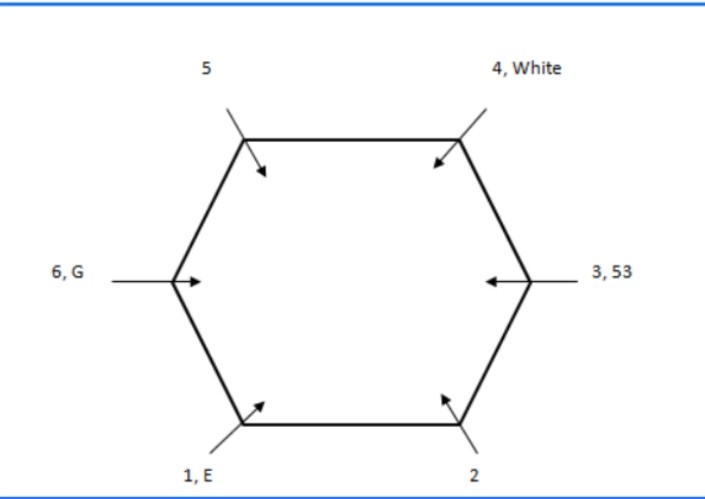
Case 2:
If E sits at place no. 1, then the one whose house is painted with White colour sits at place no. 4.
The one who lives in house no. 53 sits at place no. 5.
G sits at place no. 2.
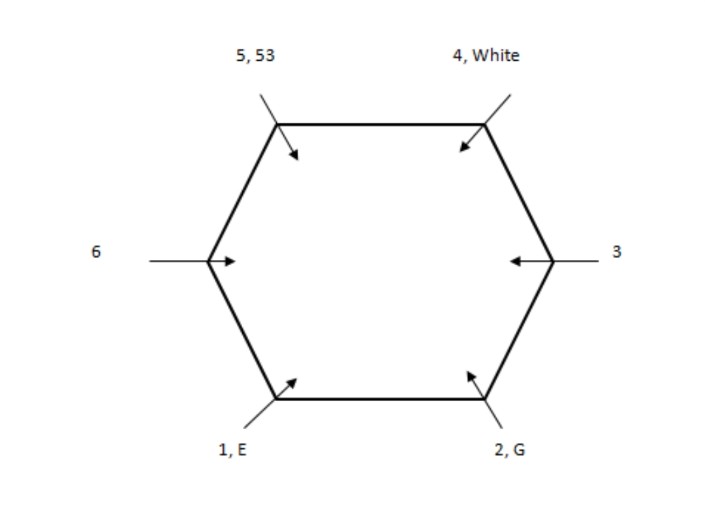
The one who lives in house no. is 54 and painted with Green sits next to G. E does not live in house no. 54 or 56.
The ones who live in 56 and 54 sit diagonally opposite to each other.
F, whose house is painted with Purple, sits to the immediate left of the one who lives in house no. 56.
Case 1:
The one who lives in house no. 54 and painted with Green sits at place no. 5 and the one who lives in house no. 56 sits at place no. 2.
This case will be discarded as E is sitting to the immediate left of the one who lives in house no. 56.
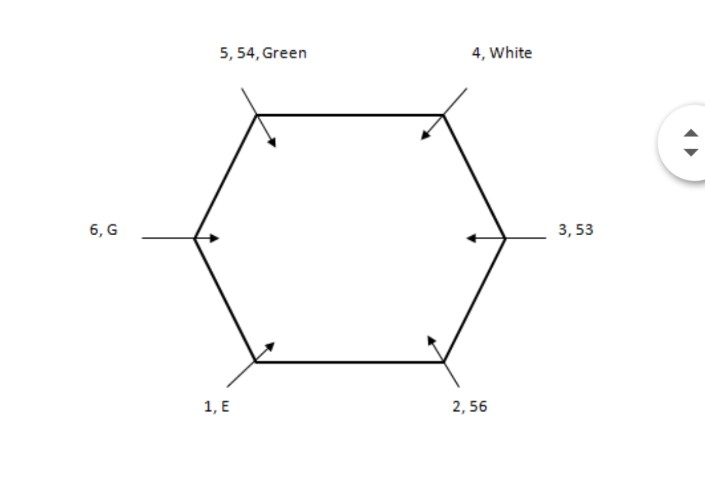
Case 2:
The one who lives in house no. 54 and painted with Green sits at place no. 3 and the one who lives in house no. 56 sits at place no. 6.
F sits at place no. 5.
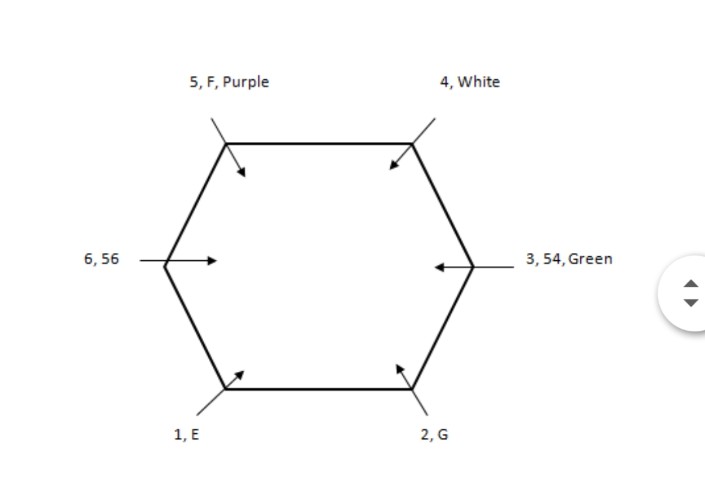
D, who lives in house no. 55 sits adjacent to H. E does not live in house no. 52. I’s house is not painted with Orange color.
G’s house is neither painted with Orange nor Blue color.
We need two consecutive places for D and H. So, D and H will sit at place no. 4 and 3 respectively. As neither I nor G’s house were painted with Orange so Q’s house was painted with Orange and I’s house painted with Blue color.
G’s house is painted with Black color. As E does not live in house no. 52, So, G lives in 52 and E lives in house no. 51.
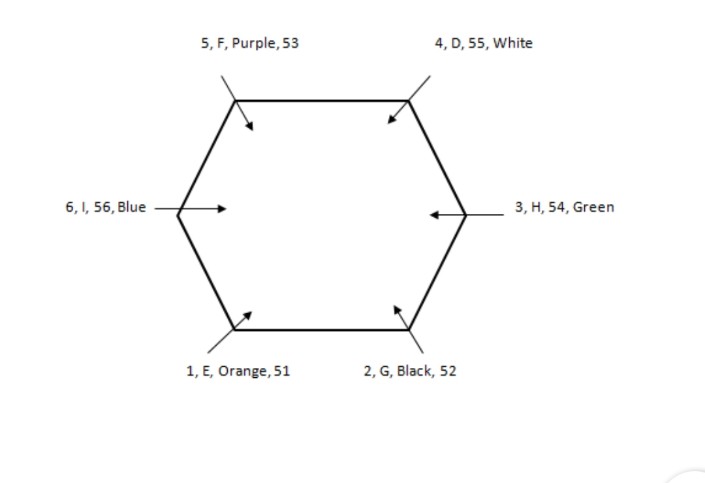
Final arrangement as shown below:
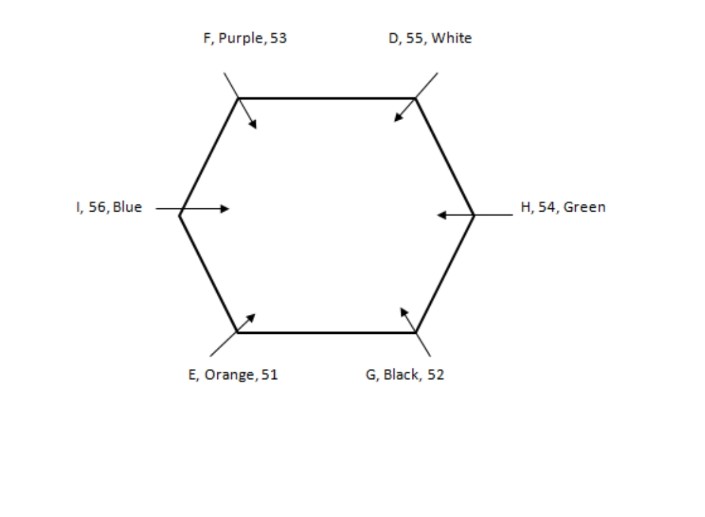
1. The person who sits second to the right of F lives in which of the following houses no.?
1) 56
2) 51
3) 52
4) 53
5) 54
Ans: 2
2. Which of the following combinations is not correct?
1) E – 51 – Orange
2) D – White – 55
3) G – Black – 52
4) I – 56 – Purple
5) F – 53 – Purple
Ans: 4
3. Who sits diagonally opposite to H?
1) The one who lives in house no. 51
2) The one whose house is painted with Purple color
3) D
4) The one who sits immediate right of E
5) The one who sits second to the left of G
Ans: 5
4. If E and F exchange their places and similarly G and D exchange their places, then who sits third to the right of D?
1) F
2) H
3) G
4) E
5) None of these
Ans: 4
5. Who among the following lives in house no. 52?
1) F
2) H
3) G
4) E
5) None of these
Ans: 3
Tips for Solving Seating Arrangement Questions
Seating arrangement questions undoubtedly rank among the most intricate challenges within the reasoning section. But, by employing suitable strategies and maintaining regular practice, you can cultivate a skill set empowering you to approach them confidently and proficiently. You will see it to be fun solving these tricky kind of questions. Below are some effective guidelines for solving seating arrangement questions:
Understand the given information: Carefully read and comprehend all the conditions, clues, and constraints provided in the question. Ensure you grasp the relationships and restrictions among individuals.
Make diagrams: Create visual representations or diagrams to map out possible seating arrangements based on the given conditions. Use symbols or placeholders for individuals and note down the information you deduce.
Identify the fixed and flexible information: Differentiate between the fixed details (information that remains constant) and the flexible ones (conditions that allow for multiple interpretations or variations). Focus on using the fixed information as the anchor for your arrangement.
Utilize clues effectively: Pay attention to clues that explicitly state seating positions, adjacent placements, directional facing, or any specific conditions. Use these clues to narrow down possibilities and eliminate incorrect arrangements.
Employ elimination techniques: Gradually eliminate improbable or conflicting arrangements based on the given conditions. This process of elimination helps refine your possible solutions.
Consider multiple scenarios: Be open to exploring different scenarios and arrangements while adhering to the given conditions. Sometimes, trying various combinations helps in identifying the correct arrangement.
Practice regularly: Enhance your skills by practicing a variety of seating arrangement puzzles from previous papers or mock tests. Regular practice improves your speed and accuracy in solving these questions.
Time management: Allocate a specific time limit for each question to avoid getting stuck. If a particular question seems too complex, consider skipping it initially and return to it later if time permits.
By implementing these strategies you can improve your proficiency in solving seating arrangement questions, thereby considerably boosting your performance in exams like the RBI Grade B and other competitive tests.
Conclusion
By comprehending and successfully tackling these question series, you will be better prepared for the upcoming RBI Grade B exam. To further familiarize yourself with the exam, it is recommended to practice with the RBI Grade B mock tests In this regard, you can rely on the assistance provided by ixamBee, a reliable resource to support your exam preparation. ixamBee offers valuable guidance and resources to help you excel in the RBI Grade B exam. Make use of these resources to enhance your chances of success.
To help you prepare 50% faster for competitive exams, ixamBee provides free Mock Test Series and all the Current Affairs in English and Current Affairs in Hindi in the BeePedia capsules for GA Preparation. You can also get the latest study materials and updates for all kinds of Bank Exams and Other Government Jobs.
Read Also
All About Puzzle Reasoning Questions in the RBI Grade B Exam
New pattern Question on Series For RBI Grade B exam
How to start RBI Grade B Exam preparation from scratch?









![Ramsar Sites in India [Updated 2022]](/blog/wp-content/uploads/2022/03/3-100x70.png)





